Intel Xeon E Six-Core Review: E-2186G, E-2176G, E-2146G, and E-2136 Tested
by Ian Cutress on November 5, 2018 12:00 PM EST- Posted in
- CPUs
- Intel
- Xeon
- Enterprise CPUs
- Xeon E
CPU Performance: Office Tests
The Office test suite is designed to focus around more industry standard tests that focus on office workflows, system meetings, some synthetics, but we also bundle compiler performance in with this section. For users that have to evaluate hardware in general, these are usually the benchmarks that most consider.
All of our benchmark results can also be found in our benchmark engine, Bench.
PCMark 10: Industry Standard System Profiler
Futuremark, now known as UL, has developed benchmarks that have become industry standards for around two decades. The latest complete system test suite is PCMark 10, upgrading over PCMark 8 with updated tests and more OpenCL invested into use cases such as video streaming.
PCMark splits its scores into about 14 different areas, including application startup, web, spreadsheets, photo editing, rendering, video conferencing, and physics. We post all of these numbers in our benchmark database, Bench, however the key metric for the review is the overall score.
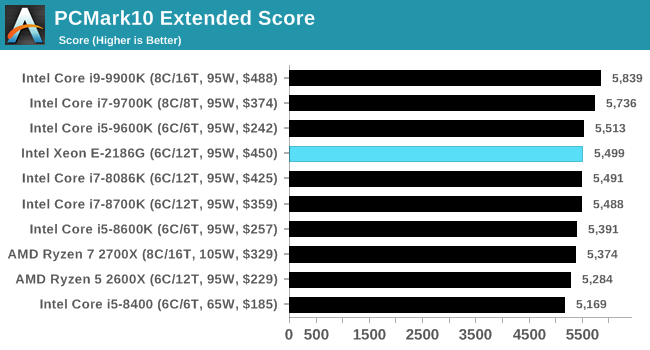
There's a slight issue using PCMark with having IGP drivers installed then restarting the system using a discrete GPU installed. We'll come back and rerun when the time permits.
Chromium Compile: Windows VC++ Compile of Chrome 56
A large number of AnandTech readers are software engineers, looking at how the hardware they use performs. While compiling a Linux kernel is ‘standard’ for the reviewers who often compile, our test is a little more varied – we are using the windows instructions to compile Chrome, specifically a Chrome 56 build from March 2017, as that was when we built the test. Google quite handily gives instructions on how to compile with Windows, along with a 400k file download for the repo.
In our test, using Google’s instructions, we use the MSVC compiler and ninja developer tools to manage the compile. As you may expect, the benchmark is variably threaded, with a mix of DRAM requirements that benefit from faster caches. Data procured in our test is the time taken for the compile, which we convert into compiles per day.
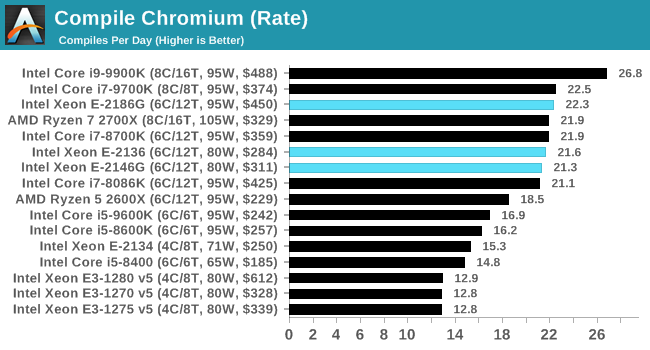
3DMark Physics: In-Game Physics Compute
Alongside PCMark is 3DMark, Futuremark’s (UL’s) gaming test suite. Each gaming tests consists of one or two GPU heavy scenes, along with a physics test that is indicative of when the test was written and the platform it is aimed at. The main overriding tests, in order of complexity, are Ice Storm, Cloud Gate, Sky Diver, Fire Strike, and Time Spy.
Some of the subtests offer variants, such as Ice Storm Unlimited, which is aimed at mobile platforms with an off-screen rendering, or Fire Strike Ultra which is aimed at high-end 4K systems with lots of the added features turned on. Time Spy also currently has an AVX-512 mode (which we may be using in the future).
For our tests, we report in Bench the results from every physics test, but for the sake of the review we keep it to the most demanding of each scene: Ice Storm Unlimited, Cloud Gate, Sky Diver, Fire Strike Ultra, and Time Spy.
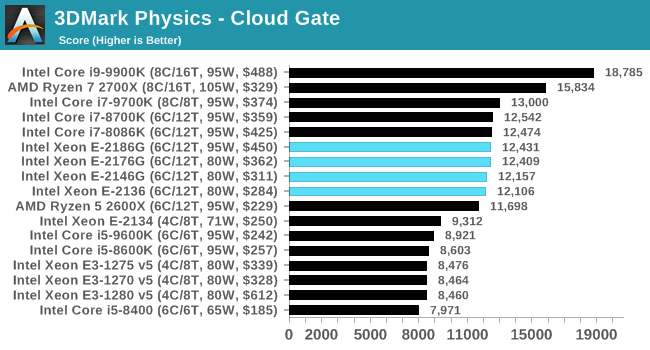
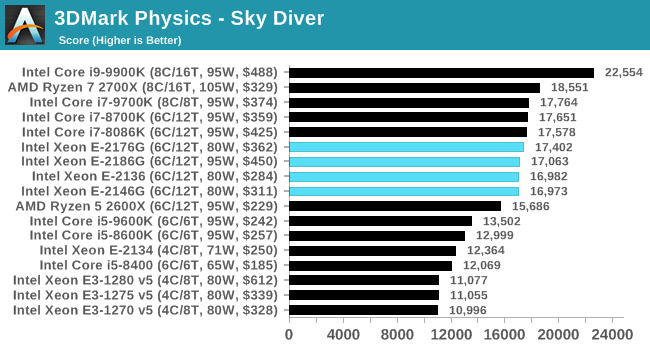
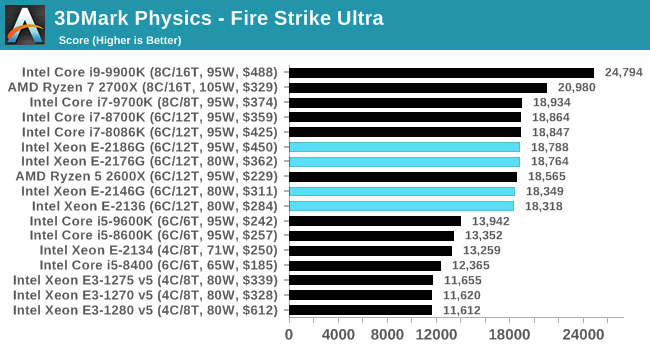
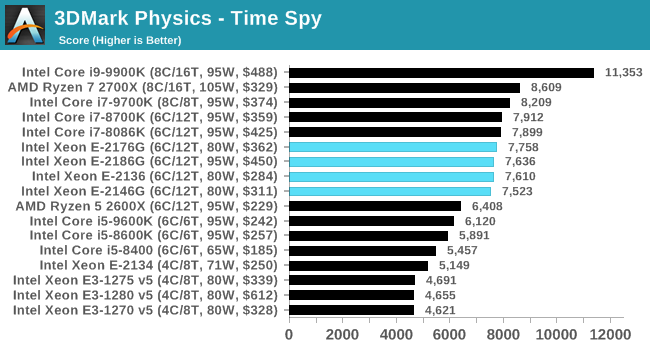
GeekBench4: Synthetics
A common tool for cross-platform testing between mobile, PC, and Mac, GeekBench 4 is an ultimate exercise in synthetic testing across a range of algorithms looking for peak throughput. Tests include encryption, compression, fast Fourier transform, memory operations, n-body physics, matrix operations, histogram manipulation, and HTML parsing.
I’m including this test due to popular demand, although the results do come across as overly synthetic, and a lot of users often put a lot of weight behind the test due to the fact that it is compiled across different platforms (although with different compilers).
We record the main subtest scores (Crypto, Integer, Floating Point, Memory) in our benchmark database, but for the review we post the overall single and multi-threaded results.
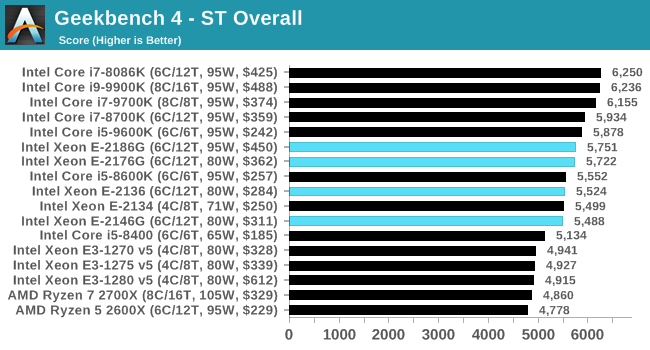











48 Comments
View All Comments
GTVic - Monday, November 5, 2018 - link
I'm wondering what is the status on the W-Series. Seems like no update/launches for over 1 year?CallumS - Monday, November 5, 2018 - link
These look great for SMB finance/inventory management/ERP applications where low latency and high single thread performance is often most beneficial. Or where software is licensed per core. Particularly if they are available within servers with OK remote management functionality at decent price points. I'd love to be able to recommend 3 or 4 of them, and the presumably upcoming 8 core configuration when it is are available, in 1U servers to SMBs rather than Xeon-SP configurations.The Intel Xeon-SP configurations are obviously still going to be the best performing and value for a lot of large enterprise/scale workloads but for smaller organisations and applications only used by under a 100 users, having the simplicity (i.e. no NUMA configuration/consideration requirements) and the performance benefits of a leaner configuration would be great. Plus, having 3 or 4 identical servers with SSD drives in RAID1 could dramatically simplify and improve a lot of local hardware related DR capabilities for organisations with moderate budgets and requirements (essentially an unplug of production SSD drives and move to another/test server).
From a market competition perspective, unfortunately it doesn't look like there is any other decent options for entry level server usage at this price at the moment. The AMD EPYC platform and CPUs are too expensive and at too lower clock speeds for a lot of business applications requiring quick response times/low latency and or licensing per core. And while AMD Ryzen CPUs are great for desktops, particularly where a dedicated GPU was already going to be required, this is actually one area where the Intel solutions can often end up cheaper and better when factoring platform costs - while also having far better support and availability. Therefore, it's really just Intel competing with themselves at the moment and enticing businesses to upgrade/invest. While not hopeful, it would be great if AMD and partners could change this.
Given that an 8700k in one of my desktops is already quicker than a lot of the 12 to 16 core Intel Xeon-SP configurations that we've also used, even for heavy load tests, due to frequency, latency, and IPC benefits, I'm really looking forward to these CPUs, and the 8 core version, hitting the market. Just the saving in per core licensing costs would probably make it cheaper to buy new servers with these CPUs than to configure new VMs on existing Xeon-SP servers for new setups.
Cooe - Tuesday, November 6, 2018 - link
Uhh... You seem to have entirely forgotten that X399 & Ryzen Threadripper exist. Plenty good single-core performance, but absolutely barnstorming multi-core for the price, ECC support, AND 64x PCIe 3.0 lanes.CallumS - Tuesday, November 6, 2018 - link
Agreed about Ryzen Threadripper CPUs being great for multi-threaded workloads and also having pretty good single core performance. I didn't forget, it's what will likely be in my next workstation, I just didn't go into that detail for the purpose of brevity.For production server purposes, atleast a basic remote management interface and support from the major vendors is generally required, though. If we could get a Ryzen Threadripper 2950X or equivalent EPYC CPU with similar frequencies in a 1RU chasis from a major vendor with decent support and management interfaces at a good price, we'd be all over it. Perhaps with the new Zen 2 EPYC CPUs about to be announced, AMD will offer something like it. I certainly hope so.
Spunjji - Tuesday, November 6, 2018 - link
It has nothing to do with what AMD are offering, unfortunately, and everything to do with what system integrators are prepared to put out there. As long as Intel is filling their pockets with plenty of MDF then I wouldn't expect to see anything soon. Hell, HP even took the iLO out of their MicroServer when they switched back to using AMD CPUs because "reasons".CallumS - Tuesday, November 6, 2018 - link
I think that it's far more likely to be a combination. System integrators still require support from manufacturers/vendors for the products/solutions that they are selling. And both AMD and Intel definitely put in mechanisms/differences to protect product lines/profit. It's not like the major vendors aren't selling EPYC systems now. A new EPYC SKU by AMD with 2950X like performance would in itself provide us with the option for a higher frequency server/EPYC CPU. Given the TDP of the Epyc 7601, it should be quite easy and practical to do from engineering and manufacturing perspectives. Or, alternatively, it should be easy enough for AMD to provide capabilities for, and to encourage, board partners to release 'server' orientated Threadripper boards. Either of which I'd love to see - but would still much prefer higher frequency EPYC SKUs due to memory and platform advantages - particularly with major system integrators already having validated EPYC server platforms.Dusk_Star - Monday, November 5, 2018 - link
Corsair Ballistix4x4GB
DDR4-2666
I feel like this should be *Crucial Ballistix* to match the rest of the "Test Setup" table.
watersb - Tuesday, November 6, 2018 - link
Awesome review, many thanks.I usually build my systems with ECC DRAM, whenever possible, but that has become a huge pain point over the past few generations.
I prefer to hear the news on these parts from AnandTech. ServeTheHome is fantastic, but nothing but $10,000+ systems gets a bit discouraging.
mkaibear - Tuesday, November 6, 2018 - link
Can I just say how much the header text (EEEEEEEE) made me laugh?Not sure why, think it just appealed to my inner surrealist.
Cheers!
CyrIng - Thursday, November 8, 2018 - link
Nice review and thanks for the Chromium results but those are professional processors which to my pov will also be employed in Linux/BSD/database/backend frameworks and so on where games don't really matter.For example, x86 and arm cross compilations such as buildroot would be great to read.
As an engineer Windows is out of the scope